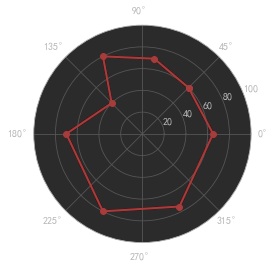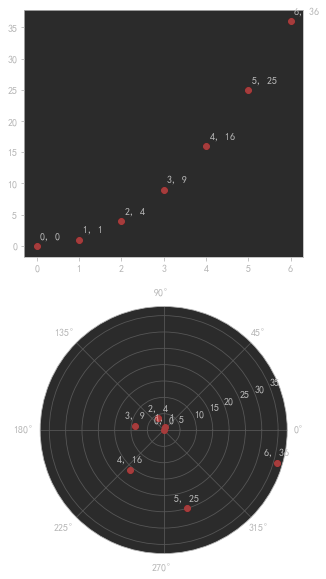import numpy as np
import matplotlib.pyplot as plt
theta=np.array([0.25,0.45,0.65,0.75,1,1.35,1.65,2,0.25])
r=[60,70,80,40,70,80,75,65,60]
plt.polar(theta*np.pi,r,'ro-',lw=2)
plt.ylim(0,100)
plt.show()
![]()
import matplotlib.pyplot as plt
import matplotlib.transforms as mtransforms
import numpy as np
xs = np.arange(7)
ys = xs**2
fig = plt.figure(figsize=(5, 10))
ax = plt.subplot(2, 1, 1)
# If we want the same offset for each text instance,
# we only need to make one transform. To get the
# transform argument to offset_copy, we need to make the axes
# first; the subplot function above is one way to do this.
trans_offset = mtransforms.offset_copy(ax.transData, fig=fig,
x=0.05, y=0.10, units='inches')
for x, y in zip(xs, ys):
plt.plot(x, y, 'ro')
plt.text(x, y, '%d, %d' % (int(x), int(y)), transform=trans_offset)
# offset_copy works for polar plots also.
ax = plt.subplot(2, 1, 2, projection='polar')
trans_offset = mtransforms.offset_copy(ax.transData, fig=fig,
y=6, units='dots')
for x, y in zip(xs, ys):
plt.polar(x, y, 'ro')
plt.text(x, y, '%d, %d' % (int(x), int(y)),
transform=trans_offset,
horizontalalignment='center',
verticalalignment='bottom')
plt.show()
![]()






 浙公网安备 33010602011771号
浙公网安备 33010602011771号